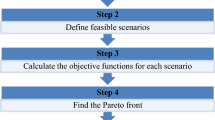Abstract
Transparent optical networking promises a cost-efficient solution for future core and metro networks because of the efficacy of switching high-granularity trunk traffic without opto-electronic conversion. Network availability is an important performance parameter for network operators, who are incorporating protection and restoration mechanisms in the network to achieve competitive advantages. This paper focuses on the reduction in Capital Expenditures (CapEx) expected from implementing sharing of backup resources in path-protected transparent networks. We dimension a nationwide network topology for different protection mechanisms using transparent and opaque architectures. We investigate the CapEx reductions obtained through protection sharing on a population of 1000 randomly generated biconnected planar topologies with 14 nodes. We show that the gain for transparent networks is heavily dependent on the offered load, with almost no relative gain for low load (no required parallel line systems). We also show that for opaque networks the CapEx reduction through protection sharing is independent of the traffic load and shows only a small dependency on the number of links in the network. The node CapEx reduction for high load (relative to the number of channels in a line system) is comparable to the CapEx reduction in opaque OTN systems. This is rather surprising as in OTN systems the number of transceivers and linecards and the size of the OTN switching matrix all decrease, while in transparent networks only the degree of the ROADM (number and size of WSSs in the node) decreases while the number of transponders remains the same.



















Similar content being viewed by others
References
Ramamurthy, B., et al. (1999). Transparent vs. opaque vs. translucent wavelength-routed optical networks, Proceedings OFC’99.
Morea, A., et al. (2005). A critical analysis of the possible cost savings of translucent networks, Proceedings Design of Reliable Communication Networks DRCN.
Doverspike, R. D., et al. (1999). Future Transport Network Architectures, IEEE Communications Magazine, Special Issue on Reliable Communication Networks.
Jarray, A., et al. (2012). CAPEX/OPEX effective optical wide area network design. Telecommunications Systems, 49(3), 329–344.
Ferreira, A., et al. (2003). Models, complexity and algorithms for the design of multi-fiber WDM networks. Telecommunications Systems, 24, 123–138.
Ramaswami, R., & Sivarajan, K. N. (1995). Routing and wavelength assignment in all-optical networks. IEEE/ACM Transactions on Networking, 3(5), 489–500.
Tak, Sungwoo, & Park, E. K. (2007). Restoration performance study of k-shortest disjoint paths in WDM optical networks. Telecommunications Systems, 34, 13–26.
Suurballe, J. W., & Tarjan, R. E. (1984). A quick method for finding shortest pairs of disjoint paths. Networks, 14, 325336.
Ho, P.-H., et al. (2003). Spare capacity allocation for WDM mesh networks with partial wavelength conversion capacity. Proceedings High Performance Switching and Routing, HPSR.
Liu, Y., et al. (2005). Approximating optimal spare capacity allocation by successive survivable routing. IEEE/ACM Transactions on Networking, 13(1), 198–211.
Staessens, D., et al. (2009). Cost efficiency of protection in future transparent networks, Proceedings of International Conference on Transparent Optical Networks ICTON.
Ishii, Y., et al. (2009). MEMS-based 1 \(\times \) 43 wavelength-selective switch with flat passband, 35th European Conference on Optical Communication, ECOC.
Gunkel, M., et al. (2006). A cost model for the WDM layer, Proceedings of Photonics in Switching.
Huelsermann, R. (2008). Cost modeling and evaluation of capital expenditures in optical multilayer networks. OSA Journal of Optical Networking, 7(9), 814–833.
De Groote, M., et al. (2010). Cost comparison of different translucent optical network architectures, Proceedings Conference of Telecommunication, Media and Internet Techno-Economics CTTE.
STRONGEST: Scalable, Tunable and Resilient Optical Networks Guaranteeing Extremely-high Speed Transport, http://www.ict-strongest.eu/
Pickavet, M., et al. (2006). Recovery in multilayer optical networks. Journal of Lightwave Technology, 24(1), 122–134.
Fenger, C. (2004). Performance evaluations for dynamic wavelength routed all-optical networks. Telecommunication Systems, 25, 117–127.
ITU-T recommendation 694.1 Spectral grids for WDM applications: DWDM frequency grid, http://www.itu.int
Gabriel, K. R., & Sokal, R. R. (1969). A new statistical approach to geographic variation analysis. Systematic Zoology (Society of Systematic Biologists), 18(3), 259270.
Acknowledgments
This work was supported by the European Commission within the STRONGEST-project (Scalable, Tunable and Resilient Optical Networks Guaranteeing Extremely-high Speed Transport), funded through the 7th ICT-Framework Programme.
Author information
Authors and Affiliations
Corresponding author
Rights and permissions
About this article
Cite this article
Staessens, D., Colle, D., Pickavet, M. et al. Analysis of resource sharing in transparent networks. Telecommun Syst 60, 503–513 (2015). https://doi.org/10.1007/s11235-015-9990-z
Published:
Issue Date:
DOI: https://doi.org/10.1007/s11235-015-9990-z




